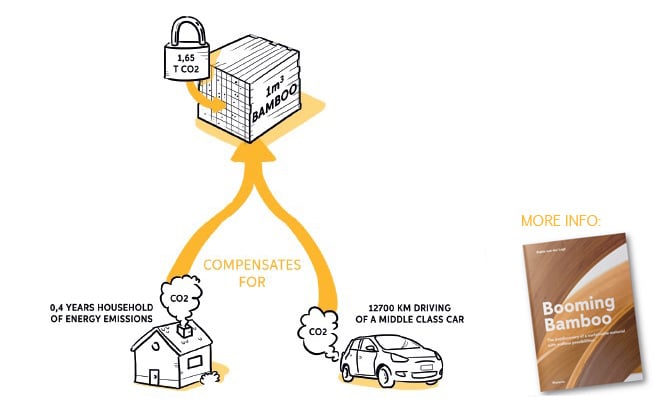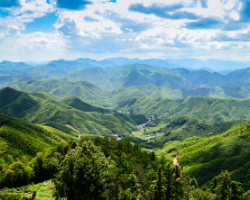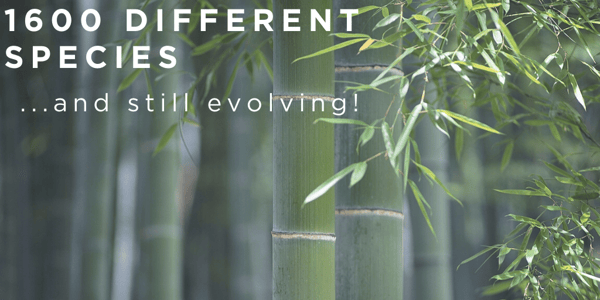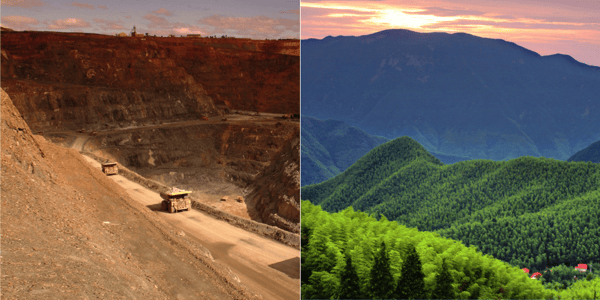The Amazon: known as the 'lungs of the earth', but in reality all trees, plants and grasses, including bamboo, are a source of oxygen. Through photosynthesis, under the influence of sunlight, they convert water and carbon dioxide (CO2) into glucose (building block for biomass), water and oxygen:
6 CO2 + 12 H2O + photons ➔ C6H12O6 + 6 O2 + 6 H2O
(carbon dioxide + water + light energy ➔ glucose + oxygen + water)
The CO2 is then stored in the bamboo, in the biomass as biogenic carbon, and in bamboo products' case in the stem. If the bamboo stem continues to grow and eventually dies, the CO2 is released back into the atmosphere. If the bamboo stem is harvested after the growth period, after 4 to 5 years, and processed into a sustainable and durable product, the carbon is locked in the material. Thus, in MOSO® Bamboo Products carbon is stored as long as the product is in use, and even longer if the material is reused or recycled e.g. to particle boards. When eventually burnt for energy, this may replace the use of fossil fuels, providing another carbon benefit.
Bio-based materials act as carbon locks
The amount of CO2 captured can be as much as 104 lb CO2 per ft³ of bamboo, looking at the heaviest materials such as Bamboo X-treme®. A positive side-effect of harvesting the bamboo stem is that the mother plant starts to produce new stems, and at the same time captures more CO2 in the forest, thus annually providing a surplus of new building material. In fact, because of the fast growth, the carbon stored in the durable products pool is higher for bamboo than for other bio-based materials, including most wood species, see this report.
How much carbon is locked in bamboo?
Calculating the carbon locked in bio-based materials, including bamboo, can be done following the European norms EN 16785-2 (for establishing bio-based content) and EN 16449 (originally designed for wood, may also be used for bio-based materials with similar biogenic carbon content). Around half of the mass of oven-dry bio-based material (wood / bamboo) consists of carbon. The ratio of the molecular weight of CO2 (44g/mol) to C (12g/mol) is 3.67. The CO2 captured in the durable products can be calculated rather simply based on the density of the bamboo species, taking into account the moisture and glue content. The greater the weight per m³, the more carbon is locked. For example, Bamboo X-treme®, with a density of around 72 lb / ft³, consists of around 90% bamboo (63 lb / ft³) with a moisture content of 12%, which is 56 lb / ft³ dry biomass at 0% moisture content. Half of this mass, 28 lb / ft³, is biogenic carbon content. Multiplied by the ratio of molecular weight of CO2 to C (3.67) results in 104 lb / ft³. This is higher than most wood species (e.g. pine at 28 lb / ft³ locks around 46 lb CO2, bangkirai at 56 lb / ft³kg/m³ locks 92 lb CO2) For custom-made calculations there are several easy-to-use carbon calculators available online, based on timber use, but these may also be used for other bio-based materials, such as bamboo. See, for example, the Centrum Hout CO2 calculator (Dutch Wood Center)
Avoiding CO2 emissions when bamboo substitutes CO2 intensive building materials
In cases where engineered bamboo material substitutes high CO2 intensive building materials, such as PVC and aluminum (e.g. for window frames, decking or cladding), CO2 emissions are avoided, known as the substitution effect. However, this added CO2 benefit is only applicable in cases where the bamboo material directly substitutes an abiotic material (thus does not apply when substituting another bio-based material). The substitution effect of the use of bio-based material in the building industry is around 1.5 tons CO2 per ton of bio-based material used instead of an abiotic material alternative. [1] This is a conservative number compared to other published substitution factors. For example, a commonly referenced meta-analysis applied a factor of 3.9 tons CO2 avoided per ton of bio-based material used instead of non-renewable materials. [2]
Do you want to know more about bamboo and carbon storage? Read "Booming Bamboo: The (re)discovery of a Sustainable Material with Endless Possibilities"
Sources

















